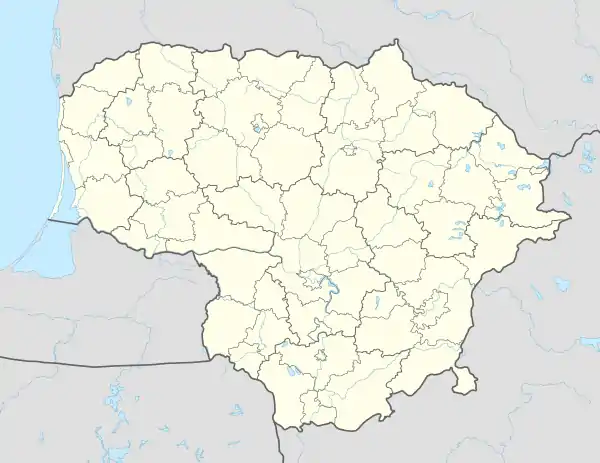Gargždai
Gargždai (ⓘ) is a city in western Lithuania located in Klaipėda County. The Minija River flows through the city.[1] Gargždai Stadium is its main sports venue.
Gargždai | |
|---|---|
City | |
 Town Square | |
 Flag  Coat of arms | |
 Gargždai Location of Gargždai | |
| Coordinates: 55°42′46″N 21°24′12″E | |
| Country | |
| Ethnographic region | Samogitia |
| County | |
| Municipality | Klaipėda district municipality |
| Eldership | Gargždai eldership |
| Capital of | Klaipėda district municipality Gargždai eldershihp |
| First mentioned | 1253 |
| Granted city rights | 1792 |
| Population (2023) | |
| • Total | 15,932 |
| Time zone | UTC+2 (EET) |
| • Summer (DST) | UTC+3 (EEST) |
Etymology
Gargždai is the Lithuanian name of the city. Versions of the name in other languages include Polish: Gorżdy, Russian: Горжды Gorzhdy, Belarusian: Го́ржды Horždy, Yiddish: גורזד Gorzhd, German: Garsden.
History


The earliest settlements of Gargždai are known to date back to Bronze Age. In written sources Gargždai was first mentioned in 1253, in the partition act of the Teutonic Order and the Curonian Bishopric (Garisda). There was a Curonians settlement and a mound in the area.[2] In 15th century the settlement moved to the western bank of the Minija River and its urban structure was linear.
The Gargždai Manor was first mentioned in the 16th century and it belonged to the Elders of Samogitia, the Kęsgaila family. Settlement was part of the estate until the 18th century. The first wooden Catholic Church of Gargždai was built 1534-1540 and founded by Queen Bona Sforza.[3] In 1597, Gargždai was named a city for the first time.
On 8 January 1600, the King Sigismund III Vasa granted the Gargždai the privilege of trade and markets. Gargždai became the most important trade point with Klaipėda. In 1639, the King Władysław IV Vasa allowed Jews to settle in the towns of Gargždai and Palanga as well as have their own plots, build houses, open warehouses, and engage in various businesses. This led to the growth and prosperity of the town, as evidenced by the found treasures of Gargždai.
The 17th and 18th centuries were difficult for Gargždai due to wars and plagues. In 1786 almost the entire city burned down. In 1792, city rights and coat of arms were granted for Gargždai. In 19th century, it was a prosperous border town as the trade and crafts expanded and the town developed as a cultural and religious center. During the World War I, almost the entire town center burned down.
The number of Jewish residents of Gargždai killed by the Nazi Einsatzkommando death squad during the Holocaust is at least 500 including 200 men killed on June 24, 1941, and 300 women with children killed on September 14 and 16, 1941. The killings were perpetrated by Einsatzgruppe A under the command of SS Brigadeführer Walter Stahlecker, and documented in the Jäger report.[1][4]
Economy

In 2015 the development of Gargždai Industrial Park (GIP) started to take place. It is located on the city boundary, in Gamyklos street. Both industrial and commercial purpose land with a total area of 9.3 hectares (23.0 acres) is offered to foreign and domestic investors. It is expected that the new industrial park will attract foreign investments, create new job vacancies for the unemployed in the region and proclaim the city of Gargždai in other countries.
Industry
Established in 1993 and now located in Gargždai, Mars Lietuva is one of the biggest Mars Incorporated plants in Europe. With around 800 Associates, "Mars Lietuva" produces more than 85 000 tones of over 400 different recipe varieties and formats of pet food annually, which is mainly exported to over 30 European countries.[5]
References
- John S. Jaffer, ShtetLinks: Gargzdai (Gorzd), Lithuania JewishGen, Inc., the Home of Jewish Genealogy. Accessed June 18, 2011.
- Ivona Vaškevičiūtė. Tautų kraustymosi ir baltų genčių sklaidos laikotarpis// Lietuvos istorija II t. Vilnius: Baltos lankos, 2007.P. 254
- Gargždai, klaipedosrajonas.lt
- "The First Mass Execution of the Jews of Gargždai". Holocaust Atlas of Lithuania. Vilnius, Lithuania: Vilna Gaon State Jewish Museum. 2010.
- "Mars Inc".
![]() Media related to Gargždai at Wikimedia Commons
Media related to Gargždai at Wikimedia Commons
